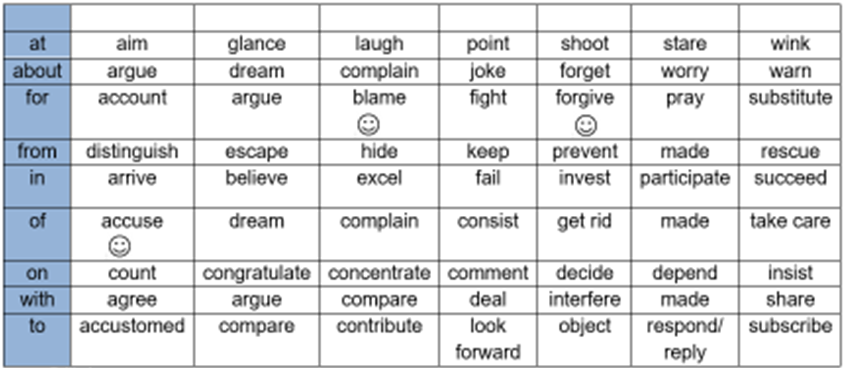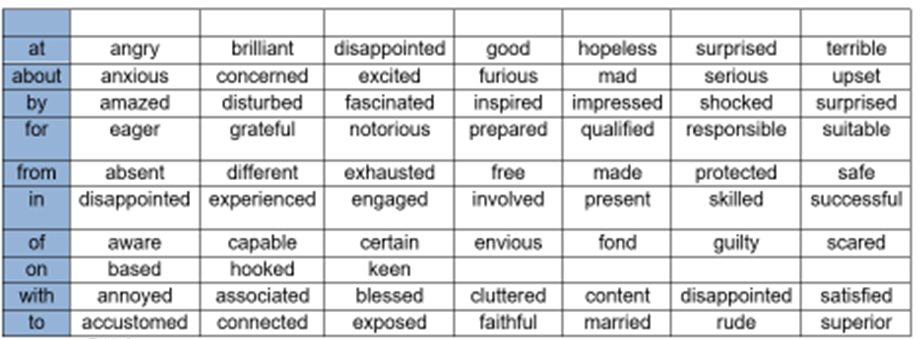I. Prepositions: their role in the English language

Prepositions are just as important in the English language as nouns, verbs, or adjectives. Whenever you are reading an article or listening to a piece of news in English you are very likely to find these particles: out, for, to, in, with, up, from, at, on, of.
While prepositions are limited in number, they are important because they act as vital markers to the structure of a sentence. Here, we will review their special relationship with verbs and adjectives.
II. Which preposition should I use?
Some verbs and some adjectives go with certain prepositions. There are no grammatical rules for which preposition is used with which adjective, so it's a good idea to try to learn them by practicing. However, there are some patterns that can help you. Check the following charts
VERBS + PREPOSITIONS

ADJECTIVES + PREPOSITIONS

III. CONSOLIDATION.
IV. EXERCISE I.
Read the sentences carefully and choose the correct preposition from the box.

V. READING TEXT.
Top 5 Ways for Small Businesses to Save Money in Their First Year

From paying vendors and tracking daily expenses to hiring someone who knows how to build a website, new business owners can find it difficult to save money in their 1st year. If funds are insufficient going into the 2nd year, the company may struggle to keep operations going smoothly. In this article, we’ll provide five tips that can help your new small business cut down on costs.
- Pick an ideal location
Ideally, a new business should be close to its customers’ locations, making it easier and more convenient for them to find it and reap the benefits of its products and services. Select an affordable area with lower rental fees and land rates. Avoid poorly lit or smelly areas and neighborhoods that have a high crime rate.
- Create a financial plan to protect your cash flow
It’s crucial to create a plan for maintaining your business’s cash flow. Prepare your budget, know how much money you have, and try to predict your expenses. Think about the amount you’ve set aside for emergencies and the insurance policy your business can afford to pay for. The insurer may be willing to customize a policy that suits your business and finances.
- Streamline your business operations
Costs begin to stack up when a small business is not operating efficiently. Inefficiencies stem from unplanned hiring, reckless spending, inadequate procurement policies, dysfunctional departments, and other issues. Human resources should know why they are hiring and how much the company can afford to secure the top talents. Hiring external workers for problems that can be fixed in-house will cost the business money.
- Build your small business website at zero to low cost
In the digital age, every business—no matter the size—must have a website to boost its brand, establish credibility, promote itself, and deliver strong customer service. A website not only helps you make money, but also helps you save money. You’ll be able to market and sell your products, share information, generate customer insights, and maintain visibility. In the past, you would have had to pay someone to do all of this for you. It’s easier to build a website for a small business now than it was in the past. One had to search for a web development company and pay exorbitant fees only to get a website that didn’t live up to their expectations.
- Understand your market
Product research will save you a lot of money from promoting something no one is interested in. Conduct surveys, perform beta tests, and ask friends for advice to be sure the market needs what you are selling.
Find out how you can improve the product or service before launching. Subtle changes in packaging, for example, can affect whether customers buy your products or not. Research your competitors to uncover any low-priced production solutions or services they may be using to reduce your product development or service costs.
VI. PRACTICE I.
VII. BIBLIOGRAPHY.
Broukal, M. (2013). Grammar: Form and Function. New York: McGraw-Hill.
Murphy, R. (2012). English Grammar in Use. Ernst Klett Sprachen.
Murray, L. (2014) English Grammar. Cambridge University Press.
Schrampfer, B. (2000). Understanding and using English Grammar. New Jersey: Prentice Hall.
VIII. WEB RESOURCES
Image 1. Капля.Смысла's word cloud ar thttps://wordart.com/gallery/user/%D0%9A%D0%B0%D0%BF%D0%BB%D1%8F.%D0%A1%D0%BC%D1%8B%D1%81%D0%BB%D0%B0
Image2_Free stock photos_ https://www.pexels.com/photo/professionals-having-a-meeting-3184287/
IX. CREDITS.
Story by Paul Kilinga. Published April 3, 2022. Text retrieved and adapted from _ Money Saving Tips for Small Businesses in Their First Year | Top 10
Practice exercise written by Beatriz Jiménez López at FES ACATLÁN UNAM
Audio version performed by Kimberly and Matt_Compra propia de licencia de uso de voces en Voicemaker, exenta de derechos de autor. https://voicemaker.in/ _Connie Reyes Cruz_2022_
Practice exercise written by Beatriz Jiménez López_English Department at FES ACATLÁN UNAM.
Practice exercise written by Beatriz Jiménez López. English Department at FES ACATLÁN UNAM.
Audio version performed by Matt_Compra propia de licencia de uso de voces en Voicemaker, exenta de derechos de autor. https://voicemaker.in/ _Connie Reyes Cruz_2022_
Table 1. Own source
Table 2. Own source